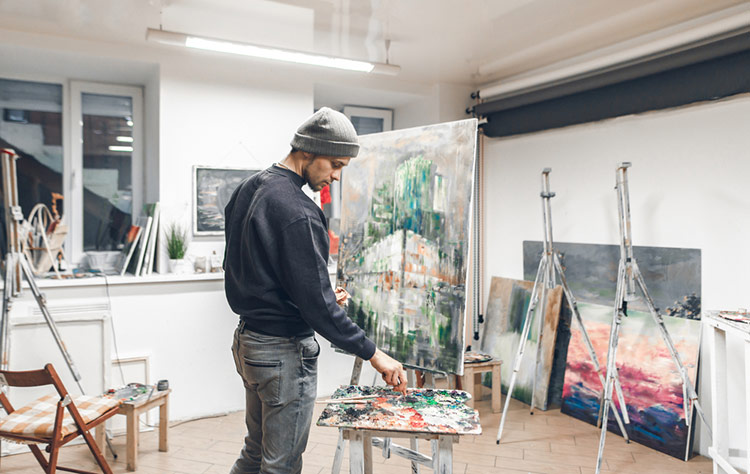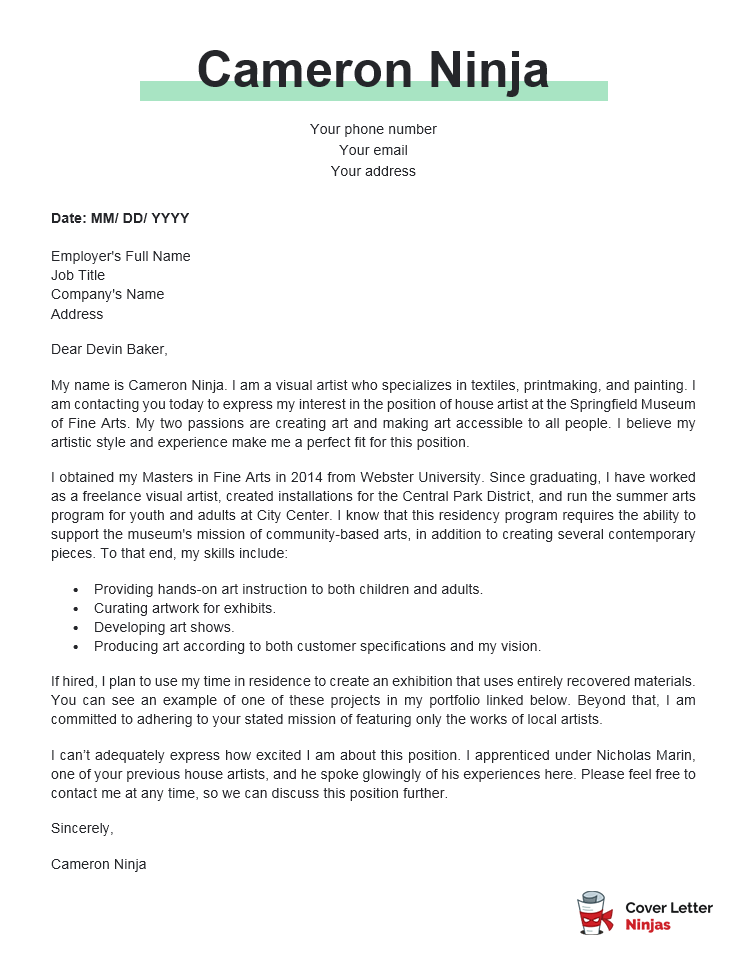
Art is a creative field, but artists have many very practical concerns. They must get paid work to survive and thrive. If you’re an artist, you may be interested in pursuing work as a freelancer, artist in residence, art instructor, or an in-house artist at a design company or production studio.
Of course, to land one of these jobs, you have to convince potential employers and clients of your worth. For that, you’ll need a great portfolio, plus a compelling resume and cover letter. Here, we’ll go over tips to help you write that cover letter, and include an artist cover letter sample.
Plan to Write Multiple Cover Letters
Every job applicant should plan to tailor their cover letter for each position as we highlight in other cover letter examples on our website. This is equally important for artists. Keep in mind that rather than having a few different requirements, your potential clients or employers may have rather contradictory visions. Take the time to understand what they want. Then, adapt your tone and content to resonate with them. First, imagine that you’re writing a cover letter to work at a fine arts summer camp for disadvantaged youth:
“I am absolutely passionate about providing opportunities for kids to express themselves through art. This is why I incorporate teaching about classic media and techniques with more modern forms of expression such as street art, manga, and augmented reality.”
Now, imagine that you’re applying to work as a consulting artist at an architectural firm:
“I have many years of experience creating artistic renderings. I take pride in producing work that allows clients to better visualize the structure that will result from the architect’s design.”
Highlight Skills That Make You Most Valuable to Employers
Now, consider your artistic skills and experience in light of what the hiring manager wants. Which of these should you emphasize? Choose the most important and relevant capabilities to highlight in your cover letter. You can address the other ones in your resume. Consider using a list to make these stand out:
- Creating photorealistic paintings.
- Translating client descriptions into 3-dimensional artwork.
- Advocating for arts funding.
- Organizing volunteers.
- Using adobe studio.
- Instructing students of all abilities and ages.

Debi Douma-Herren
Senior Certified HR Professional & Career Coach
Describe Your Style
It may seem contradictory, but your cover letter should serve two functions. It should prove that you can provide what your client wants. At the same time, you must emphasize your commitment to your unique style. This will give insight into your vision as an artist. Here’s a brief example:
“I create art that draws attention to human frailty. I combine digital media with found objects and traditional sculpture. My goal is to urge people to see art in things that aren’t traditionally beautiful. I hope to touch those who see art as more than a means to provide aesthetic pleasure.”
Point to Your Portfolio With a Relevant Example
Of course, you should mention your portfolio in your cover letter, but do it in a relevant way. Find work in your portfolio that you believe best represents what you want to show the reader. Then, use that as an example to link your portfolio. For example:
“Last year I painted a portrait commemorating a client’s 50th wedding anniversary. I think you’ll agree that it demonstrates my ability to capture emotion. Feel free to check it out along with the rest of the works in my portfolio.”
Be Specific About The Art You Produce
Keep in mind that the person reading your cover letter may not have a background in the arts. In addition to sharing your artistic vision, be very clear about the kind of art you create. More importantly, describe what type of art you are planning to produce for that particular client. Otherwise, you could be in a real mess later on as you deal with poorly managed expectations.
Artist Cover Letter Sample in .docx Format

Download example (Word version)
Artist Cover Letter Example – Text Format
My name is Cameron Ninja. I am a visual artist who specializes in textiles, printmaking, and painting. I am contacting you today to express my interest in the position of house artist at the Springfield Museum of Fine Arts. My two passions are creating art and making art accessible to all people. I believe my artistic style and experience make me a perfect fit for this position.
I obtained my Masters in Fine Arts in 2014 from Webster University. Since graduating, I have worked as a freelance visual artist, created installations for the Central Park District, and run the summer arts program for youth and adults at City Center. I know that this residency program requires the ability to support the museum’s mission of community-based arts, in addition to creating several contemporary pieces. To that end, my skills include:
- Providing hands-on art instruction to both children and adults.
- Curating artwork for exhibits.
- Developing art shows.
- Producing art according to both customer specifications and my vision.
If hired, I plan to use my time in residence to create an exhibition that uses entirely recovered materials. You can see an example of one of these projects in my portfolio linked below. Beyond that, I am committed to adhering to your stated mission of featuring only the works of local artists.
I can’t adequately express how excited I am about this position. I apprenticed under Nicholas Marin, one of your previous house artists, and he spoke glowingly of his experiences here. Please feel free to contact me at any time, so we can discuss this position further.
Sincerely,
Cameron Ninja
Final Tip: Mention Your Influences
You can help your reader become familiar with your approach to art by mentioning your influences. If there’s an artist who has had an impact on your style, feel free to drop a name. This will help create a sense of familiarity, especially if your work isn’t very well-known.
